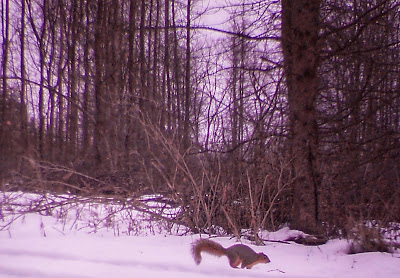For most of my adult life my exposure to squirrels was namely city-dwelling Eastern Gray Squirrels. They were ubiquitous to urban life and were more of an annoyance if anything. They raided bird feeders, gnawed-on house siding and soffit and invaded attics and fireplace chimneys.
And for many years there were no tree-dwelling squirrels here at The Platz. Ground squirrels tunneled in the septic mound and took-up residence in the rock wall. That was the extent of our known squirrel population
Beginning with 2018 another species of squirrel arrived.
Meet Sciurus niger - the Eastern Fox Squirrel - the largest of the tree squirrel family although slightly smaller than the common gray squirrel.
At
first blush you might guess this to be a Red Squirrel. However,
lacking in this photo is the Red Squirrel's distinctive bright white
belly and white rings around the eyes. The rusty coloring and large
bushy tail are reminiscent of a fox - implying this is a Fox Squirrel.
The
bright orange pelt of this animal and it's loud, scolding call make it
an easier visual and audible identification. Unlike the Eastern Gray
Squirrel this species has a wider home range and spends more time on
the ground foraging.
In the last three years they've been showing-up with increasing frequency on the trail cameras. My conclusion is that as our forest has matured along with acorn production from the oaks is that the resident population has increased.
They're active year-round and January and February is their mating season so there's likely more chasing of the ladies happening too.
Fun to observe and without destructive tunneling behavior I'm tickled (so far anyway) to have them around.






No comments:
Post a Comment